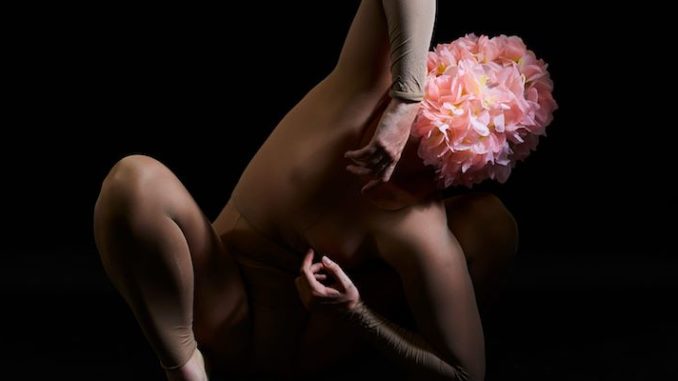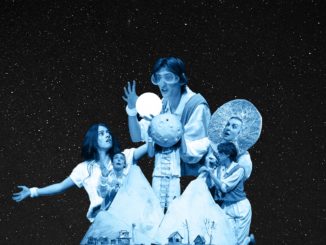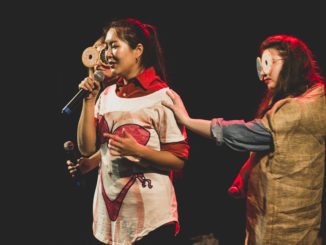
[An Open Body]
Perhaps the best thing about seeing a dance piece like this is its openness to interpretation. It is visual and auditory but without any text to impose meaning on the audience, leaving us to be affected by what we see in a visceral and extremely personal way. Critiquing, by nature, is an act of interpretation – itself a kind of dance between the critic and the work. This was certainly my experience of Faceless Hair Cry, my mind and soul oscillating between different feelings and associations, as the work moved through its stages, repeating and transforming.
A contemporary dance solo performed and choreographed by Sofia McIntyre, Faceless Hair Cry takes us on a strange and emotional journey – at times disturbing, at others enchanting, but always deeply fascinating.
Two feet are seen behind a large, black box in the darkness. Slowly, a body emerges, rigid and doll-like, as if being moved by some external force. This body has no face, just an engulfing floral mask, like pink hair, over the area where the head should be. As this creature moves through space, it is alternately sexual and panicked – sometimes pulsating, gyrating, offering its body to us, then stuck, struggling, performing some desperate ritual. The lighting (designed by Zane Allen) seems to mirror this with its sometimes abrupt changes, taking us from sensual and dim to a stark illumination of the space, while the soundscape blankets us in the world. These different states juxtapose as well as inform each other, never letting us see the erotic as totally separate from the anxious.
It seems to me this is a statement on femininity, sex and power. The flower is a perfect metaphor for this – beautiful and enticing but ultimately without agency, simply waiting, open, to be pollinated. Sofia’s costume is nothing but a body stocking – its pink colour suggesting softness – that leaves her body exposed, while her lack of face feels like objectification. The incredible sound design (by Paloma Schneideman) immerses us in an array of shifting sounds – what I first hear as bees buzzing I later think could be the distorted sound of female pleasure. But, even during the more seductive or tender moments in the movement, the soundscape never lets us be at ease. It is always caving in on us with a Lynchian eeriness that suggests, to me, there is something wrong about this display of sexuality.
The faceless creature journeys through different iterations of itself, constantly trying to get up but forever being pulled down, and obsessing over particular movements. Even after shedding its petals, it seems to feel the need to keep its face hidden, this time using Sofia’s own hair – perhaps it doesn’t feel the right to personhood, or is afraid of such bold self-identification. Once it is finally standing, we become witness to a slow, sultry dance. It is dream-like and beautiful, but also robotic, reinforcing the idea of sexuality linked to a lack of control. And, by the end, the creature has returned to its place behind the black box, perhaps ready to repeat this cycle all over again.
The journey of this creature – is it a flower, a vagina, a woman, none of the above? – seems a constant struggle between the polarising forces of fear and desire. As I leave the theatre, moved and introspective, I wonder if this desire is real or projected (a reflection of the ‘male gaze’). How do we impose ideas of sexuality and femininity onto others? Can one have true desire without agency? Or is it all up to interpretation?
It also occurs to me that these questions might reflect more about me than anything else. Perhaps, because of my own life and experiences, I’m unable to see the show outside of a feminist lens, where all body and no face inherently suggests objectification. Others might read the show as empowering, or as representing something completely different, like a struggle with depression, or body image.
During her expertly crafted performance, Sofia (AKA the creature) leaves her body open to be projected upon, inviting ideas of sexual ferocity without providing any easy explanations of what they relate to. The show is described as ‘a romantic duet danced solo’, suggesting another side of this we never see; something lost or missing, perhaps a search for meaning itself. And, through our function as spectator, perhaps it is us who are invited to provide this missing piece.
It is the act of interpretation that makes a work truly worthwhile – for, if you’re not engaging your audience in some kind of dialogue, what is the work for? Whatever your unique experience of Faceless Hair Cry, I guarantee this piece will captivate you from start to finish, and make you feel and question and wonder.
Faceless Hair Cry plays at Basement Theatre as part of Auckland Fringe 3-7 March, 2020.




Leave a Reply